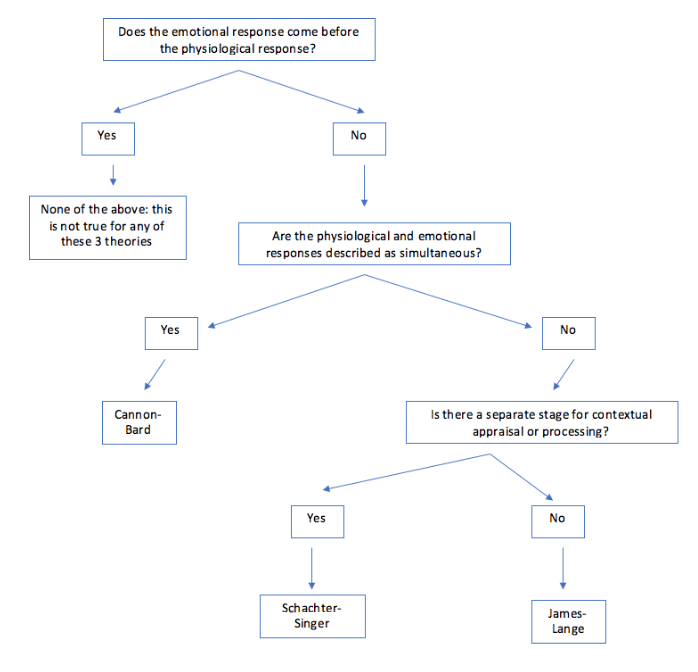The James-Lange, Cannon-Bard, and Schachter-Singer theories of emotion are an important topic for the Psychological and Social, and Biological Foundations section of the MCAT, and are also a perennial source of confusion for students due to the need to distinguish carefully between multiple theories named after different psychological researchers, such that the names of the theories don’t provide much of a “hook” for understanding the differences between them. We cover them in greater detail in our Online MCAT Course, as well as in live Office Hour sessions with our instructors.
The Origins of These Theories
Stepping back, it’s helpful to understand the point of these theories. They were developed as attempts to answer the question of how we can have internal, emotional responses to external stimuli: in other words, how does an external stimulus interact with our bodies such that we can have feelings about it? As a background point, it’s interesting to note that some of these theories are relatively old: the James-Lange theory was developed in the late 1800s, the Cannon-Bard theory was developed in the 1920s, and the Schachter-Singer theory was developed in the 1960s. Especially for the James-Lange and Cannon-Bard theories, it is not productive to worry about how much they agree with modern neuropsychological research: instead, for the MCAT, you’re expected to understand the basic proposals of these theories and how they can be applied to various situations. Intuitive reasoning is enough to get you where you need to be in that regard.
Let’s work through the various theories in the context of a scenario where you see a bear, get scared (with physiological responses including elevated heart rate and blood pressure, characteristic of the sympathetic nervous system), and run away. We might imagine the following sequence of events: stimulus (bear) à emotional response (fear) à physiological response (elevated heart rate, etc.) à behavior. It turns out that this is almost certainly not right, and we can understand the James-Lange, Cannon-Bard, and Schachter-Singer theories as a set of improvements on the above account.
A Look at the James-Lange Theory and Schacter-Singer Theory
The James-Lange theory involves a simple modification of our scenario described above: the physiological response is thought to happen immediately after the stimulus, causing the emotional response. Schematically, we can think of it like this: stimulus (bear) à physiological response (elevated heart rate, etc.) à emotional response (fear).
Many critiques of the James-Lange theory have been raised, but one issue to notice is that different people can have different emotional responses to similar or identical stimuli and the physiological responses to those stimuli. For instance, some people love watching horror movies and getting scared, and other people don’t. Moreover, our emotional response to a stimulus might depend on the context: sympathetic nervous system activation (elevated heart rate, etc.) might be enjoyable in the context of a horror film but frightening in the case of what appears to be a real threat.
The Schachter-Singer theory addresses this problem by adding a second stage to the James-Lange theory, as follows: stimulus à physiological response à contextual appraisal à emotion/behavior.
Remember that James-Lange and Schachter-Singer are a conceptually linked pair of theories, and that J comes before S, in the sense that the James-Lange theory was modified by the Schachter-Singer theory.
Dissecting the Cannon-Bard Theory
The Cannon-Bard theory of emotion, in contrast, proposes that after a stimulus, the physiological response (elevated heart rate, etc.) and emotional response in the brain happen simultaneously and separately, and jointly lead to a response. The key words are simultaneous and separate.
Remember that for the MCAT, you don’t have to distinguish between all possible theories of emotions – instead, you just have to tell these three apart. You can do so using the following flowchart:
In general, flowcharts are a tremendously useful technique for studying psychology and sociology concepts, because they push you to move away from studying and recognizing definitions towards a more active approach based on how these concepts are actually tested on the MCAT (i.e., in multiple-choice questions).
Need additional help on the Psych/Soc section of the MCAT? The Next Step Online MCAT Course was created by experts with 524+ MCAT scores, including MDs and PhDs. We constantly update our MCAT practice tests to reflect the latest AAMC interface and changes; get a free full-length by signing up for the Free MCAT Practice Bundle. If you need more individualized attention, our MCAT tutors provide one-on-one MCAT tutoring personalized to address your unique needs and weaknesses. What works for some may not work for all, so it’s important to find the right MCAT prep that works for you. Schedule a free consultation with our experienced Academic Managers to start you on the path to MCAT success.
Search the Blog

Free Consultation
Interested in our Online MCAT Course, One-on-One MCAT Tutoring or Med admissions packages? Set up a free consultation with one of our experienced Senior Student Advisors.
Schedule NowPopular Posts
-
MCAT Blog What's on the MCAT?
-
MCAT Blog How to Review MCAT Full Lengths

Free MCAT Practice Account
Need great MCAT practice?Get the most representative MCAT practice possible when you sign up for our free MCAT Account, which includes a half-length diagnostic exam and one of our full-length MCAT practice exams.
Learn More








